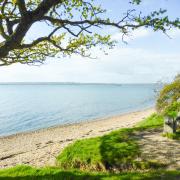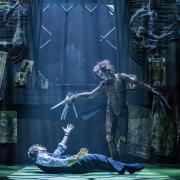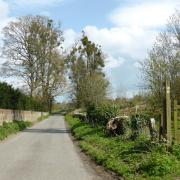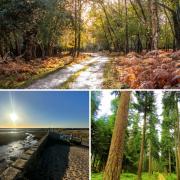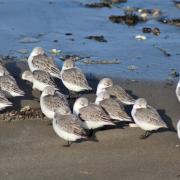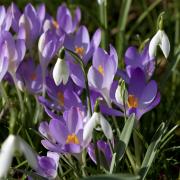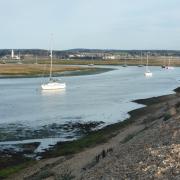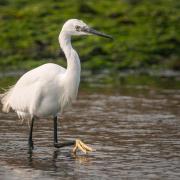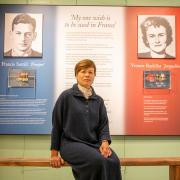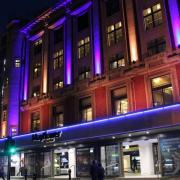Earlier this year, ‘The Observatory’ arrived at Winchester Science Centre creating a window into the work of three contemporary artists. Now this extraordinary rotating studio has its temporary home and three new occupants at Lymington’s Keyhaven marshes. Viv Micklefield finds out what happens when art goes outside the gallery
Is it a sculpture, a kind of shelter perhaps or somewhere in which to work? When it comes to The Observatory, the answer is: all of these. And that’s the point. This unique structure is designed to act like a beacon, drawing the visitor’s attention to the landscape in which it resides, and whether we know anything about art, or not, to get us thinking.
With Hampshire chosen as the starting point for The Observatory’s two-year journey around southern England, there’s already been a chance to glimpse the original drawings, films and words triggered by the ancient rolling hills of the South Downs National Park. After initially being installed behind Winchester’s Discovery Centre, it has recently move to a spot under the big skies of the coastal salt marshes in Lymington - and who knows what’s in store next? Space, Placemaking and Urban Design (SPUD), the Sway-based team also behind last year’s internationally acclaimed Exbury Egg project, equally can’t wait to learn.
“This time we’re in very public locations,” says SPUD’s Mark Drury. “Winchester Science Centre gets around 150,000 visitors a year, with people able to go outside and meet the artist working there. And in Lymington, a considerable number walk along the sea wall even in winter, so, again, The Observatory is easy to get to, and to experience.”
Approaching the structure’s two elements – one a weatherproof artist’s ‘study’ (there’s even a wood burner for extra comfort) the other an open-sided ‘workshop’, it instantly invites closer inspection. The angular contours are pierced by apertures that frame both the space within and the surroundings. And while the interior has a distinctly nautical feel being timber clad in sustainable Siberian larch, the exterior is shrouded in an unusual Japanese-inspired charred finish that, in turn, contrasts with the woven rope sculpture ‘wall’. It’s a feat of ingenuity designed, following a national competition, by graduate architects at London’s Feilden Clegg Bradley Studios, and custom-built by Andover based S&S Construction.
So, what do the artists involved during 2015 make of this goldfish bowl-like experience? “Puts you on the spot”, “Exciting and terrifying at the same time”, “A sharing process” - are among the reactions expressed by the six selected from over 100 applicants. They’ve had carte blanche to use the space as they wish for two months (unlike the Exbury Egg’s solo residency), before handing it over to the next artist in line.
“The Observatory really pushes you into the landscape, in the same way that a boat floats yet is in the sea,” says Isabella Martin who worked at Winchester between May and June. Unsurprisingly, for this multi-disciplinary artist “from the flatlands of East Anglia” and her predecessor, animator Sean Harris who’s usually based in the Welsh mountains, the South Downs initially felt alien. However for sculptor Simon Ryder, who grew-up in East Meon and christened The Observatory in January, it was, “nice to come back and make something for the home patch”.
“Cut the earth and you’ve got your drawing material,” he observed at the time, following a scout for flints on nearby Chesford Head, adding, “I’ve always had an admiration for those Victorians who roamed over science and art. The more I look out to a great distance the more I want to look into the very small, and find a connection between those two.”
Simon’s talk at the Science Centre’s Planetarium, against the backdrop of Philae’s troubled landing on a faraway comet and his own large-scale chalk drawings depicting the geological remains of microorganisms, provided an unusually personal insight into an artist’s mind and his research. As did Sean’s magical mythological creatures superimposed on to the night sky during his publically screened exploration of the idea of wilderness and culturally different ways of looking at the natural world.
As he explained to anyone dropping by, his ‘journey’ as an artist means there’s more to come from him. “I’ve been working on these flip-book boxes. They are printed bits of paper inside but turn the handle and they become alive. I’m making a series inspired by stories of the constellations that I hope will become a ‘thinking path’ into the landscape.”
Similarly, Isabella’s hoping to use the shared experience of walking with local ramblers to create an audio guide featuring multiple voices as ‘virtual companions’. Having closed-in on her immediate surroundings by camping overnight in a tent, schoolchildren from St Swithun’s in Winchester also viewed the world differently, using the artist’s homemade telescopes. “I’ve been forced into having conversations with people right from the beginning, and trying to communicate ideas as they emerge,” she says.
Motivating more of us to explore our shifting landscapes with fresh eyes lies at the heart of this £50,000 Arts Council funded project. Thanks also to support from Hampshire County Council, Winchester City Council, the South Downs and New Forest National Parks, as well as sponsorship from suppliers, as the call goes out to find six more artists for next year’s locations in Dorset and Cornwall, the urge to look-in, look-out seems to be growing.
And amongst the visitors to The Observatory so far has been composer Marc Yeats who, at a time when several national galleries are inviting musicians to interpret their artworks, is producing an original piece in response to all the artists and sites involved.
“He’s the thread that links everything together,” says Mark Drury. “While the artists themselves, are coming up with ways of showing people that art’s not scary and that it’s not something that only happens in a white box.”
Visit The Observatory
• Getting there: The salt marshes lie between Lymington and Keyhaven village
• By car: Use Lymington’s Bath Road car park (S041 3SE) and follow signs for the Solent Way. The Observatory can be found by Eight Acre Pond
• By public transport: The nearest station is Lymington Town - several bus routes service Lymington or the New Forest Tour bus runs until mid September
Exhibition
The work of all six artists who have occupied The Observatory during 2015 will be shown at Lymington’s St Barbe Museum and Gallery (www.stbarbe-museum.org.uk) next spring, 5 March - 16 April 2016.
***
READ ON
• The best things about living in Lymington - From stories of smuggling and sea salt to summer sailing and superb shopping, Emma Caulton celebrates living the high life in the seaside town of Lymington








